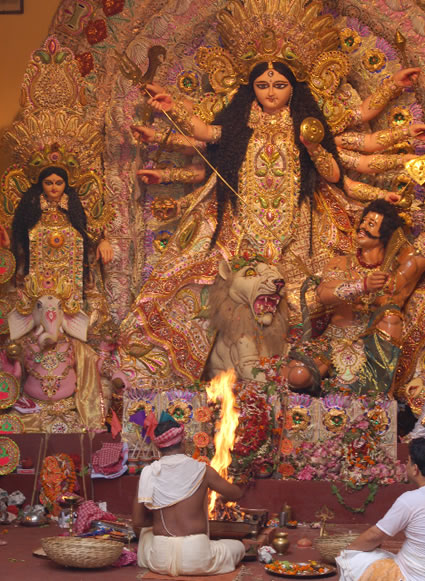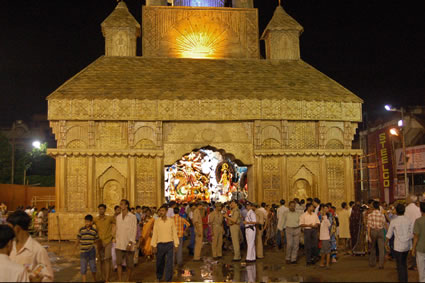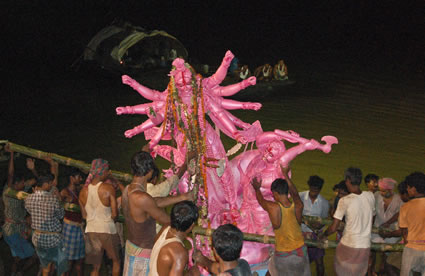Honoring the Warrior Goddess
India’s Durga Puja Celebration
By Volker Poelzl

|
|
A priest performing a ceremony during Durga Puja. @Volker Poelzl.
|
India is a land of holy places, holy rivers, and prominent religious festivals. Almost every aspect of life is infused with sacred gestures, rites, and meaning. The importance of Hinduism as India's most dominant religion extends far beyond the private sphere into the public realm. Every year, hundreds of religious festivals and pilgrimages are celebrated across this vast and diverse country, and witnessing or participating in one or several of them is a significant cultural or spiritual experience for foreign visitors. Among India's most colorful and lively festivals is Navratri (Festival of Nine Nights), and Durga Puja is one of the most popular versions of this festival celebrated in Eastern India, especially in the city of Kolkata (Calcutta) in the state of West Bengal. For five days each year, the city takes on a festive atmosphere. It comes to a complete standstill when temporary temples spring up all over the city to honor the Hindu goddess Durga. Hundreds of thousands of worshippers from Kolkata and India visit these temples to pay tribute.
I
The Story Behind Durga Puja
Navratri is a celebration of the victory of good over evil, with several variations of the tradition throughout India. Durga Puja celebrates explicitly the triumph of the goddess Durga over the bull demon Mahishasura. According to legend, Durga was summoned by the gods Brahma, Vishnu, and Shiva to defeat the demon who had set out to conquer the world. To help her win the battle, each of the major Hindu gods gave Durga weapons and other objects to assist her. Durga went into action mounted on a lion, and on the tenth day of the battle, she finally killed the demon. Navratri commemorates the nine days and nights of the struggle between good and evil. Still, Durga Puja is celebrated only on the last five days, when, according to legend, Durga leaves her heavenly abode to visit Earth yearly. Durga Puja attracts many visitors from all over India and foreign tourists. Still, the festival is especially popular among the people of West Bengal. The festival is a special occasion for Bengali families to come together from all over the country and celebrate with their relatives and communities.
The Pandals
At the center of the Durga Puja celebration is the "pandal," a temporary pavilion and place of worship where ceremonies and rituals occur. The city issues over a thousand permits for pandals in public spaces yearly, and they spring up in every neighborhood across Kolkata. Pandals are usually built with bamboo slats and papier-mâché and are richly painted and decorated. Artisans work for months to build them and make beautiful clay idols of the goddess and her family. The creation of clay idols is an especially sought-after craft, and only the most expert artisans are hired. Each pandal has an altar displaying the idols of Durga and other gods. Durga is usually depicted with eight or ten arms, sitting on a lion, with the defeated demon beneath her. She is generally accompanied by the idols of her sons Ganesh and Kartik and her daughters Lakshmi and Saraswati. These clay sculptures are richly dressed and decorated with flower garlands and jewelry.
Some pandals are small and straightforward, funded by communities and neighborhood associations through neighborhood fund-raising. However, a growing number are very flashy and expensive, often sponsored by large businesses and corporations. Each pandal usually has a dedicated theme that varies from year to year and is often a replica of famous Indian temples. They may also have an ethnic theme or represent famous landmarks around the world. There is an ongoing competition between the different puja committees to develop creative and unexpected themes each year to attract the most visitors. Some pandals of past Durga Puja celebrations have gained notoriety for daring and untraditional designs, sometimes provoking criticism from purists.

|
|
Pandal-hopping is a favorite night-time activity during the festival. @Volker Poelzl.
|
A Time of Devotion and Merriment
For Hindus, "Puja" is a form of worship of a god through prayers, rituals, and songs. Even though Durga Puja is a merry feast and social event with many secular elements, it is inherently a religious celebration to honor the goddess Durga. During the five-day event, people pay tribute to the goddess. People make offerings and honor her in ceremonies, prayers, and songs. Each of the five days of the festival has different ceremonies and rituals, which are performed by a priest at each pandal before large crowds of worshippers. Most people attend their community pandal for daily ceremonies, music, dances, and food but they also visit other pandals. This so-called "pandal-hopping" is a well-established tradition. Families dress up in their best clothes as they visit pandals all over the city and offer their prayers before the idol of Durga. There is live music and dancing, and the streets are crowded with pandal-hoppers and street vendors offering crafts, curiosities, snacks, and henna hand paintings loved by the local ladies. Durga Puja is a time for family members to come together from all over the country and invite guests into their homes to enjoy special seasonal dishes. It is also a time when people go shopping and buy new clothes, jewelry, household items, and gifts.
The Conclusion of Durga Puja: The Immersion

|
|
A group of men lower a clay idol of the goddess Durga into the river. @Volker Poelzl.
|
On the fifth day of Durga Puja, communities gather for a last religious ceremony before the idols of Durga are paraded through the streets and then transported to the Hooghly River for immersion. This symbolizes the end of Durga's five-day sojourn on earth, after which she returns to her heavenly abode. Traffic to the riverbank comes to a standstill that night as hundreds of hired trucks transport the idols of the displays to the river, together with dozens of revelers. As the crowd watches on, often accompanied by musicians, the clay idols of Durga and the other gods are carefully unloaded and carried down to the river, where they are gently lowered into the water. Then, the idols are picked up by the current and slowly swept downstream. Over the next few days, all the pandals in the city are dismantled, only to be reborn in a new shape and glamour the following year.
|
For More Information on the Durga Puja
When to Go
Durga Puja is celebrated in late September/early October each year. October is an excellent time to visit India since foreign tourists do not yet crowd India's main attractions, the weather is mostly dry, and the heat is beginning to subside. Still, late monsoon rains can hit Kolkata during Durga Puja, leading to extensive flooding and traffic jams.
It is best to arrive a few days before the beginning of Durga Puja to get your bearings before the city shuts down for the festival. This should give you enough time to find out which restaurants, shops, and cafés are open and how to get around town during the festival. Government offices and banks are closed during the festivities, commerce has irregular opening hours, and restaurants have long lines. Plan ahead.
How to Get to Kolkata
You can fly to Kolkata from Delhi, but if you have time, take the train and visit several great destinations, such as the Taj Mahal in Agra and the holy city of Varanasi. Durga Puja is a popular time for family reunions and also attracts tourists from all over India. Train and airline tickets may sell out quickly, and hotels may be booked more frequently. Making advance reservations is a good idea to ensure you have a pleasant place to stay.
Getting around Kolkata
If you are staying near the city center, traveling by cab is the best way to get around Kolkata. If you travel in a group, consider hiring a vehicle and driver for a few days to visit several pandals all over the city.
For more information about Durga Puja, visit these websites:
Durga Puja
IloveIndia.com
|
Volker Poelzl is a Living Abroad Contributing Editor for TransitionsAbroad.com.
|
